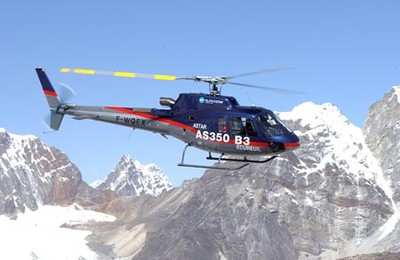Blasts FAA For Poor Oversight And Not Following NTSB
Recommendations
 The NTSB Tuesday determined the
probable cause of a 2005 fatal air tour helicopter crash in Hawaii
as "the pilot's decision to continue flight into adverse weather
conditions, which resulted in a loss of control due to an encounter
with a microburst."
The NTSB Tuesday determined the
probable cause of a 2005 fatal air tour helicopter crash in Hawaii
as "the pilot's decision to continue flight into adverse weather
conditions, which resulted in a loss of control due to an encounter
with a microburst."
The board also said inadequate FAA surveillance of compliance
with Special Federal Aviation Regulation (SFAR) 71 operating
restrictions contributed to the accident, and the lack of
helicopter flotation equipment contributed to the loss of life.
On the afternoon of September 23, 2005, an Aerospatiale AS350BA
helicopter (file photo of type below), registered to Jan Leasing,
and operated by Heli-USA Airways, encountered adverse weather and
crashed into the Pacific Ocean several hundred feet off the coast
of Kailiu Point, near Haena, HI.
The flight departed from Lihue Airport for an intended 45-minute
tour of Kauai island. Three passengers died of drowning or
drowning-related circumstances; the commercial pilot and two other
passengers received minor injuries.
Investigators noted air tour pilots typically use their own
judgment, based on the appearance of the weather conditions, to
determine whether to proceed with a flight and the island's unique
weather patterns involving daily, brief, localized rain showers,
means air tour pilots sometimes encounter and briefly penetrate
areas of precipitation during flights.
The helicopter was not equipped with flotation equipment and
sank quickly after hitting the water. Although each occupant
wore a waist pouch containing a vest-type personal flotation device
(PFD) and were briefed on its use, not all were able to put it on
and properly inflate it after exiting the downed chopper. One
surviving passenger said the helicopter touched down and rolled on
its side submerging the cabin within about three seconds.
In a 1995 report on the US air tour industry, the board noted
that combined use of PFDs and helicopter flotation equipment
provided an optimum level of safety for passengers in the event of
an emergency ditching, and urged the FAA to reconsider the SFAR 71
rule that allowed Hawaii air tour operators to provide only one or
the other.
On October 22, 2003, the FAA issued for public comment a
proposed rule that would have required most types of air tour
helicopters operating over water to be equipped with fixed or
inflatable floats. However, says the NTSB, the final rule,
while providing for enhanced oversight of commercial air tours,
falls short on mandating helicopter flotation devices when PFDs are
provided.

"This flight into dangerous weather conditions had tragic
consequences," said NTSB Chairman Mark V. Rosenker, "but lives
might have been spared if the helicopter had flotation
equipment. I am disappointed that the rulemaking process once
again has moved so slowly and that the final result still leaves
open a real safety gap."
The board recommended that FAA require that "all helicopters
used in commercial air tour operations over water, regardless of
the amount of time over water, be amphibious or equipped with fixed
or inflatable floats."
The board also recommended that the FAA evaluate the design,
maintenance, and in-service handling to determine why some chambers
of a PFD fail to inflate.
Heli USA Responds
 Late Tuesday, Heli USA issued a
statement in response to the NTSB's findings.
Late Tuesday, Heli USA issued a
statement in response to the NTSB's findings.
"We would like to express our deepest appreciation to both the
National Transportation and Safety Board and the Federal Aviation
Authority for their extensive efforts in investigating this
incident and their assistance in promoting safety in the airline
industry," the company said in a release to ANN.
"From the investigation our helicopter had no mechanical
problems, company policies were appropriate and the helicopter was
equipped with government-required safety equipment, including
personal flotation devices ... Since this event, Heli USA has
installed additional safety equipment including external inflatable
floats on its helicopters even though they are still not required
under the new FAR 136 rule. The company has done so, so that its
helicopters can fly beyond autorotative distance from shore and
conduct inter-island commercial operations."
Heli USA notes it is one of only two helicopter companies
operating on Kauai with external inflatable floats -- and that the
pilot of the accident flight isn't flying, pending recertification
by the FAA.
 ANN's Daily Aero-Linx (04.15.24)
ANN's Daily Aero-Linx (04.15.24) Classic Aero-TV: 'No Other Options' -- The Israeli Air Force's Danny Shapira
Classic Aero-TV: 'No Other Options' -- The Israeli Air Force's Danny Shapira Aero-News: Quote of the Day (04.15.24)
Aero-News: Quote of the Day (04.15.24) Airborne 04.16.24: RV Update, Affordable Flying Expo, Diamond Lil
Airborne 04.16.24: RV Update, Affordable Flying Expo, Diamond Lil ANN's Daily Aero-Term (04.16.24): Chart Supplement US
ANN's Daily Aero-Term (04.16.24): Chart Supplement US




